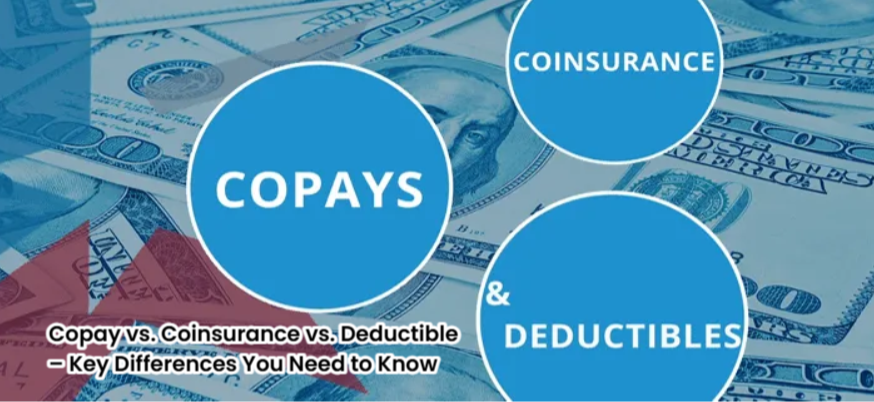Health insurance is an essential safeguard against soaring medical expenses. As healthcare costs rise quickly, a good health insurance policy can save your money. It protects you from large expenses if you face a serious illness, such as a heart attack, kidney failure, or cancer. Without insurance, a single medical emergency could deplete your savings in no time.
Before purchasing a health insurance plan, it is crucial to understand some key terms related to your policy. Awareness of these terms can help you make informed decisions and choose a plan that best suits your needs. This blog explains three essential concepts in health insurance: deductible, copay, and coinsurance. Let’s dive into their definitions, features, and differences.

What is a Deductible in Health Insurance?
A deductible is the set amount you pay before your health insurance begins to cover your medical costs. It serves as the initial expense you are responsible for in a claim.
For example, suppose your health insurance policy has a deductible of ₹5,000. This means you must pay ₹5,000 first when you file a claim, and only after that will your insurer cover the remaining expenses. If your total claim amount is ₹1,00,000, you will pay ₹5,000 from your own pocket, and your insurer will cover ₹95,000.
Key Features of Deductibles in Health Insurance:
- Helps insurance companies minimize unnecessary claims.
- Allows policyholders to reduce their health insurance premiums.
- May vary depending on individual and family health insurance plans.
What is a Copay in Health Insurance?
A copay, or copayment, is what you pay for a medical claim. The insurance provider pays the rest. Unlike a deductible, which is a fixed amount, copay is generally expressed as a percentage of the total claim.
If your health insurance policy includes a 10% copay and your medical expenses are ₹1,00,000, you will pay ₹10,000. Your insurer will then cover the rest, which is ₹90,000.
Key Features of Copay in Health Insurance:
- The policyholder shares a small part of the claim amount, reducing the insurer’s liability.
- Copay amounts vary depending on the medical service being availed.
- Policies with higher copay clauses usually have lower premium costs.
- Common in senior citizen health plans and metropolitan cities where healthcare costs are higher.
- No copayment clause means the insurance provider bears the entire healthcare cost.
How to Check if Your Health Insurance Policy Includes a Copay Clause?
To determine if your health insurance policy has a copayment clause, carefully review the policy documents. If you’re unsure, you can also contact your insurer’s customer support team for clarification.
What is Coinsurance in Health Insurance?
Coinsurance is the part of the claim that the policyholder pays after the deductible is met. The insurer covers the remaining portion. Like copay, coinsurance is also expressed as a percentage of the total claim amount.
For example, if your policy has a deductible of ₹5,000 and a coinsurance clause of 10%, here’s how it works:
- If you file a claim of ₹1,00,000, you first pay ₹5,000 (deductible).
- The remaining claim amount is ₹95,000.
- You pay 10% of ₹95,000 as coinsurance, which is ₹9,500.
- Your total out-of-pocket expense is ₹5,000 + ₹9,500 = ₹14,500.
- The insurer will pay the remaining ₹85,500.
Key Features of Coinsurance in Health Insurance:
- Protects insurance providers from excessive claim payouts.
- Involves significant out-of-pocket costs for the policyholder.
- The percentage remains fixed across all medical services.
- There is an out-of-pocket maximum beyond which you won’t have to pay coinsurance.
Copay vs. Coinsurance vs. Deductible: Understanding the Differences
Copay vs. Deductible
Parameter Copay Deductible
Meaning
- A fixed percentage of the claim that the policyholder pays.
- A set amount paid before the insurer covers medical costs.
Application
- Varies by medical service used.
- Applies to all claims, no matter the service type.
Impact on Premium
- Higher copay leads to lower premium costs.
- Deductibles may not affect premium costs directly.
Copay vs. Coinsurance
- Parameter Copay Coinsurance
- Meaning A fixed amount the policyholder pays per visit. A fixed percentage of the claim amount that the policyholder must pay.
- Payment Clause Paid each time a claim is filed. Paid only after the deductible is used.
- Timing of Payment Paid at the time of claim filing. Paid after medical care is received.
- Deductible Usually does not apply. Applies only after the deductible is met.
Deductible vs. Coinsurance
Parameter Deductible
- Meaning: A fixed amount paid before the insurer covers costs.
- Payment Clause: Must be paid for every claim.
- Amount: Fixed amount, regardless of claim size.
- Drawbacks: Minimal drawbacks due to fixed payment.
Coinsurance
- Meaning: A percentage of medical expenses paid after the deductible.
- Payment Clause: Paid only after the deductible is met.
- Amount: Varies based on the total claim amount.
- Drawbacks: Higher claim amounts lead to greater out-of-pocket expenses.
What is Copay After Deductible?
Some health insurance policies have a copay after deductible clause. Here’s what it means:
- You must first pay the deductible before your coverage starts.
- Once the deductible is met, you also pay the copay amount on every claim.
- Deductible and copay amounts are calculated separately.
Should You Buy a Health Insurance Policy with Deductible, Copay, and Coinsurance Clauses?
Choosing a health insurance policy with deductibles, copay, or coinsurance can lower your premium costs. However, this also means that you may have to bear substantial out-of-pocket expenses during a medical emergency.
To make a smart choice, compare policies, check their features, and see how they fit your financial needs. Always read the fine print carefully to ensure there are no hidden clauses that may impact your claim settlement.
Lastly, for complete financial protection, think about getting health insurance and life insurance. A life insurance policy helps protect your loved ones if something unexpected happens. Health insurance makes sure that medical bills don’t cause you financial stress.
Conclusion
Understanding deductible, copay, and coinsurance helps you choose the right health insurance policy. Each of these factors affects premium costs and out-of-pocket expenses. So, finding the right balance between affordability and coverage is crucial for a secure financial future.
Before buying a policy, compare options. Talk to a trusted insurance provider to find the best plan for you.
Must read:
- Can Predictive Churn Analytics Transform Insurance from Risk to Retention?
- Why Buying Health Insurance This Festive Season is a Smart Financial Move
- Honda Activa 6G Insurance Secrets: Save Big & Get Maximum Protection!
